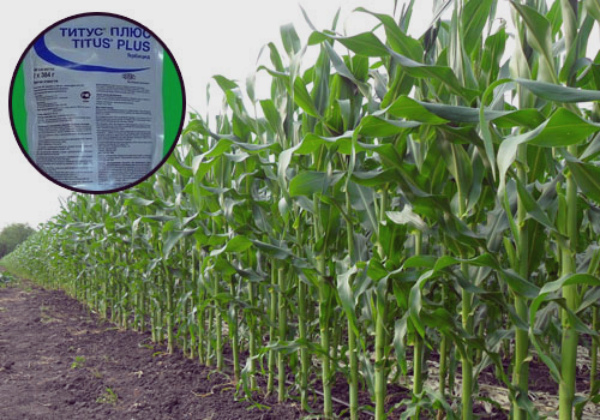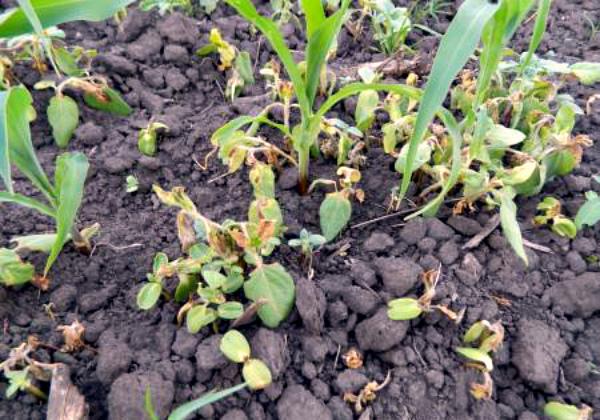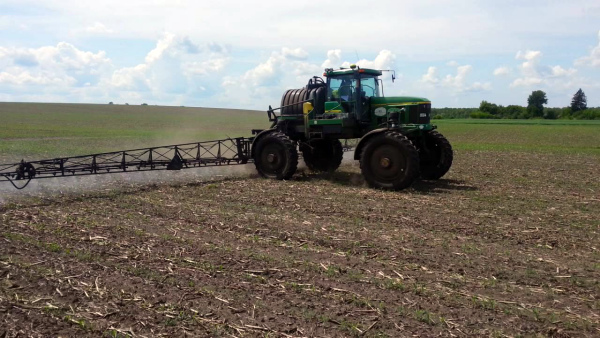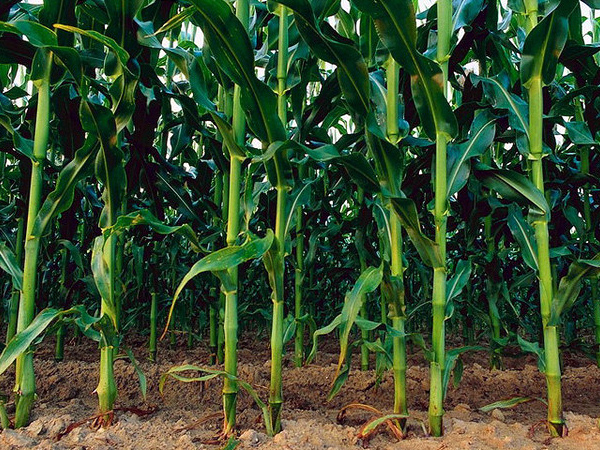How to apply corn herbicides
Content
What are herbicides
The very term "herbicide" means a chemical used to kill plants. Herbicide-based preparations allow you to effectively and quickly get rid of unwanted vegetation. According to the principle of action on plants, they are subdivided into preparations of selective (selective) and continuous action.
The latter are capable of killing all types of vegetation. Their area of application is the destruction of unnecessary plantings around and on the territory of industrial facilities: on roads, airfields, under power lines, in reservoirs, canals. Selective drugs are designed to protect crops from weeds. They are used in the cultivation of corn.
Herbicide treatment is popularly called “chemical weeding”. This is a really good comparison, as there is no trace left after applying the weed killer.
With proper use, they are completely safe for crops, but it often happens that not only weeds, but also cultivated plants are destroyed. Such an outcome is possible if the herbicide is chosen incorrectly, or an excessive amount of it has been applied.
It is important to understand that any herbicide is a fairly strong chemical designed to remove persistent weeds. If crops of economic importance are treated with such a preparation, then there is a high probability that the plants will stop growing, or the crops will simply die from burns. As for corn, its processing makes sense only if there are a lot of weeds, and it is impossible to apply other, more gentle methods of dealing with them. This is usually the case when corn is grown in the fields on a very large scale.
There is a very wide variety of corn herbicides available today, making it difficult to choose the best one. The most common are preparations based on 2,4-D amine salt, clopyralid, sulfonylureas, acetochlor. Each of the active ingredients has its own characteristics of use.
Amine salt is effective in good hydration. In dry conditions, this herbicide can partially burn the corn, and also significantly slow down its growth. The principle of action of the drug is not in drying out weeds, but in stopping their growth and gradual death. Many business executives are perplexed and disappointed by the fact that even a few days after using the product, the weeds remain green and unharmed. However, one should not think that the herbicide is ineffective, it just takes 30-40 days for the complete destruction of the plantations.
Clopyralid is a very potent post-emergence herbicide. Sulfonylureas are systemic preparations of a very wide spectrum of action with high selective activity against weeds.When used in tandem, the results can be astonishing.
The choice of the drug depends not only on the active substance, but also on the purpose of its purpose, the type of weed and the time of application.
Corn can be processed by the following means:
- The trimmer is a universal systemic preparation for the control of the main annual and perennial dicotyledonous weeds. It is used after germination when plants reach 3-5 leaves.
- Quasar is a systemic post-emergence drug against annual and perennial weeds.
- Miranda is a complex preparation in the form of a suspension designed to destroy weeds already in crops.
- Aztec is a soil herbicide used when planting corn.
- Triton is a preparation for the control of annual and annual weeds. The principle of action is the absorption of the substance by the leaves and rapid movement to the points of growth, which leads to the rapid death of weeds.
- Turbin is a highly active drug against annual cereal weeds. It is used in crops.
This is not the whole list of herbicides. There are also drugs that are introduced into the soil even before sowing corn: Merlin, Saga. They are very convenient to use, as they rid crops of weeds at the right time - at the initial stage of growth. However, processing with such means has a significant disadvantage - excessive drying of the soil.
Video "How to Apply Herbicides"
In this video, a plant expert explains how to properly apply herbicides.
Weed species
Corn belongs to heat-loving crops. Many gardeners grow it from seedlings, and plant it in open ground with the onset of warm days.
When cultivating corn on a large scale, there is no opportunity to grow seedlings, so the grains are sown directly into the ground at the end of spring. Moreover, the first shoots may appear only by mid-June.
Late sowing and slowly developing seedlings lead to the fact that corn suffers more than other crops from weeds, which have time to grow well in the spring.
Weeds, like cultivated plants, are subdivided into annuals and perennials, which in turn are divided into monocotyledonous and dicotyledonous. The annual monocotyledonous weeds that most often attack maize include barnyard grass, bristle grass, wild oats, crabgrass, millet varieties. Of dicotyledonous annuals in corn plantings, most often grow: blue cornflower, highlander, peas, jaundice, Mary, shiritsa, chisetz and many others.
From perennials, corn is often replaced by field thistle (sow thistle), bindweed (popularly called birch), dandelion, euphorbia, wormwood, ambrosia. Horsetail is common in moist soil.
Getting rid of these plants is very difficult. Even repeated treatment with herbicides does not always remove these weeds, since they are capable of producing new shoots. Another challenge in weed control is that many species grow quite late after the plantings have been cultivated. In addition, most weeds are prone to self-sowing, so the corn field has to be cultivated several times per season.
Processing instructions
Since any herbicide is a very active chemical, its application must be extremely careful and correctly dosed. Before using the drug, you should read the instructions on the package. For each product there is an exact dosage, method of application and types of weeds, from which it is effective.
Corn can be processed in two ways: embedding in the soil and spraying weeds. In both cases, liquid solutions are used, which are diluted at the concentration recommended by the instructions.
For spraying, solutions of a stronger concentration are used, since under the influence of wind, rain and other natural factors, the herbicide is partially removed from the weeds.It is noticed that when sprayed on the leaves, no more than 30% of the drug remains. Both methods have their pros and cons. The advantages of spraying include the exclusion of soil contamination, and a significant disadvantage is the fact that when spraying, weeds die more slowly.
If the herbicide is applied to the soil, then the solution must be carefully spread over the surface so that it penetrates no lower than the planted grains. When using soil preparations for corn, it is necessary to pay attention to the conditions under which they are active. For example, many of these herbicides are inactive in dry soil. If there is no rain, or it happens very rarely, there is a high probability that by the time the soil is moistened, the active components have already disappeared, and their introduction will be useless. This also applies to preparations based on 2,4-D amine, dicamba, which are active only in moist soil. In addition, they can be used in strictly defined terms - when 3-5 leaves appear on the sprouts.
Almost all drugs are applied in the morning or in the evening, since a prerequisite for their safe use is a temperature regime that does not exceed 25 ° C. At a higher degree, the products have a toxic effect not only on the corn, but also on the person who processed the plants. Therefore, when working with such substances, you must protect yourself - wear protective clothing, shoes and a respirator.
It is important to understand that the introduction of herbicides into the soil for corn is an irreversible process. Their validity period lasts from 1 to 2 months. In this case, the active substances penetrate into the roots, stems and leaves, which, of course, affects the quality of the crop. Therefore, corn is stopped about 1–1.5 months before harvest. If corn is planned to be harvested in milk maturity, then the use of drugs is stopped no later than a month before the collection of young heads of cabbage.
Video "Protecting corn from weeds"
This video is a simple visual aid to effectively protect corn from clogging using MaisTer technology.







